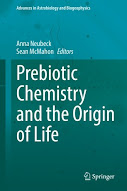I try to read broadly in my field: the chemistry of the origin of life. The latest compilation of articles in book form is Prebiotic Chemistry and the Origin of Life (Springer, 2022) edited by Neubeck and McMahon.
Essay #5 in the book is “Origin of Nucleic Acids” by Frank Trixler. The title is ambitious. The contents are a mess. Or maybe I’m just not smart enough to pull all the threads together. The chapter starts off promisingly. Trixler poses several interesting questions. Among them: Why is AMP (adenosine monophosophate) so common? Why does life use just four nucleobases? How do we solve the water paradox? What makes a nucleotide sequence functional? And what is the genetic code encoding anyway?
I hadn’t thought much about the ubiquity of AMP so I found this section interesting. Trixler points out the many places it shows up, but doesn’t satisfactorily answer why it is ubiquitous. He makes the claim that its “catalytic activity is of very high statistical significance” in a crowded fluid system such as you might find in cells. These “nanofludic effects” supposedly arise from structural considerations, but Trixler’s arguments sounded like Kipling-esque Just So stories. I was unconvinced.
Why don’t we have multiple versions of the genetic code? Standardization is Trixler’s answer. I’m inclined to agree in a broad sense, although it’s less clear why nature has picked out the pterin nucleobases (A,C,G,T/U) that we use for the four-letter code. There are numerous chemical cousins that also can also exhibit base-pairing and form alternative or even expanded codes. No clear answer here.
The next two sections are titled “A Paradox Falls Into Water” and “The Crystalline Womb”. Trixler favors minerals and solid surfaces to facilitate polymerization of nucleic acids to generate sequences. I personally think that inorganic materials played an important role at life’s origin but much of these sections quote experimental results so broadly as to be less than relevant to the question at hand. Montmorillonite, the magical clay, comes up again as expected, in a Just So way. Nothing new here.
Then there’s a
section about “Functional Sequence Complexity” as proposed by Abel. Trixler makes the argument that thinking about
Complexity as a one-dimensional function, with “order” at one end and “randomness”
at the other, needs to be supplemented by two other measures: algorithmic
compressibility and algorithmic function. But then he claims that functional
complexity lies in this special space – and there’s a graph to demonstrate this
– but no evidence whatsoever. There’s a connection to lichen growth, but if he
was trying to make an argument here, I just didn’t grasp it. (The Abel reference was interesting but mainly arguing for a negative, and thereby inconclusive at the end.)
You’d think I would give up after the mess so far – like wading through a pigsty of facts thrown around willy-nilly. But then there’s a beautiful gem, a pearl of wisdom and clarity that shines through. Here’s a snapshot of the two relevant paragraphs.
While I disagree with the word ‘all’ in the first sentence, I felt that Trixler lays out the thermodynamic viewpoint cleanly and clearly. Since this echoes how I look at things, his first paragraph is preaching to the choir, but it’s not new to me. The second paragraph is the real winner for me for distinguishing what living organisms do! I can’t say it any better so I won’t try to paraphrase. It’s the pearl in the pigsty!
Unfortunately, that’s it. The remaining sections about the chicken-and-egg DNA-protein paradox, or the idea of dynamic kinetic stability, are a mishmash. I was a little dazed after I finished reading the article. It sounded to me like one of my confused students trying to do a data dump at a superficial level, pulling in threads all over the place with bits and pieces of “evidence”. Or perhaps a better analogy is that this is what I sound like to some of my students. Stuff is coming out of my mouth expounding on some chemistry topic and they feel totally lost possibly because they didn’t read or don’t remember what they’ve learned that we’re trying to build on. Or maybe it’s somewhere in between the two. Unbelievably, I decided to download a couple of other Trixler papers where he provides “evidence” for some of his statements, and I gave up after skimming them. I gave up trying to check for pearls in a pigsty – at least that’s what it looks like to me. Possibly I’m ignorant or my mind isn’t able to see majestic threads being pulled together. All I saw was mostly mess. But I won’t discount the beautiful pearl – and for that it was worth making my way through the article.


No comments:
Post a Comment